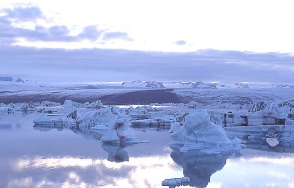 |
 |
Iceland
Iceland is Europe's westernmost country,
the second largest island in the North-Atlantic ocean, a little over 3 hours
flight from London, Paris, Amsterdam or Copenhagen. The first settlers came to
Iceland from Norway and Ireland in the 9th century. Althingi, the world's oldest
functioning legislative assembly, was established in the year 930 A. D. Iceland
has a strong economy, low unemployment and low inflation. Per capita income is
among the highest in the world. In environmental terms, Iceland is unique. It is
a large country (103,000 km², about the same surface area as Ireland or the
State of Virginia), but is sparsely populated, with only 3 persons per km²
living mostly along the coast. The interior of the country contains stunning
contrasts. It is largely an arctic desert, punctuated with mountains, glaciers,
volcanoes and waterfalls. Most of the vegetation and agricultural areas are in
the lowlands close to the coastline.
Climate
Iceland has a relatively mild coastline climate. The average summer
temperature in Reykjavik, the capitol is 10.6C/51F in July, with average highs
of 24.3C/76F. The average Winter temperature in Reykjavik is similar to New York
City's, about 0C/32F in January (average highs are 9.9C/50F). Usually the
weather is very changeable. The mild
climate stems from the Gulf Stream and attendant warm ocean currents from the
Gulf of Mexico. The weather is also very affected by the East Greenland polar
current curving South-Eastwards round the north and East coasts. For two to
three months in Summer there is continuous daylight in Iceland, and early Spring
and late Autumn enjoy long twilight. However the days are very short in mid
Winter.
Glaciers
Among the most distinctive features of Iceland are it's glaciers, which cover
over 11,922 km squared, 11.5% of the total area of the country. During the past
few decades, however, they have markedly thinned and retreated owing to a milder
climate, and some of the smaller ones have all but vanished. By far the largest
of the glacier caps is the Vatnajokull glacier in Southeast Iceland with an area
of 8,400 km squared, equal in size to all the glaciers on the European mainland
put together. It reaches a thickness of 1km/3000 feet. One of its Southern
outlets, Breidamerkurjökull, descends to sea level.
Reykjavik
Reykjavik, the capitol of Iceland, is the country's largest city and the worlds
most Northerly capitol. The capitol area includes seven municipalities in
addition to Reykjavik itself, with a total population of about 170,000, of which
over 180,000 live in Reykjavik. Reykjavik means "Smoky Bay", so named
by the first settler in the 9th century because of steam rising from geothermal
hot springs. This geothermal energy is utilized to provide economical,
non-polluting heating to the city's buildings. Hence Reykjavik is one of the
cleanest cities in the Western world. One of the country's best salmon rivers
run right through the city. Reykjavik offers historical sites, natural beauty,
museums, and galleries, public parks, excellent shopping, a wide range of
leisure activities, hotels, restaurants and a remarkably lively artistic scene.
There are many theatres and galleries and one can go to symphony concerts, the
ballet or opera.
 |
 |